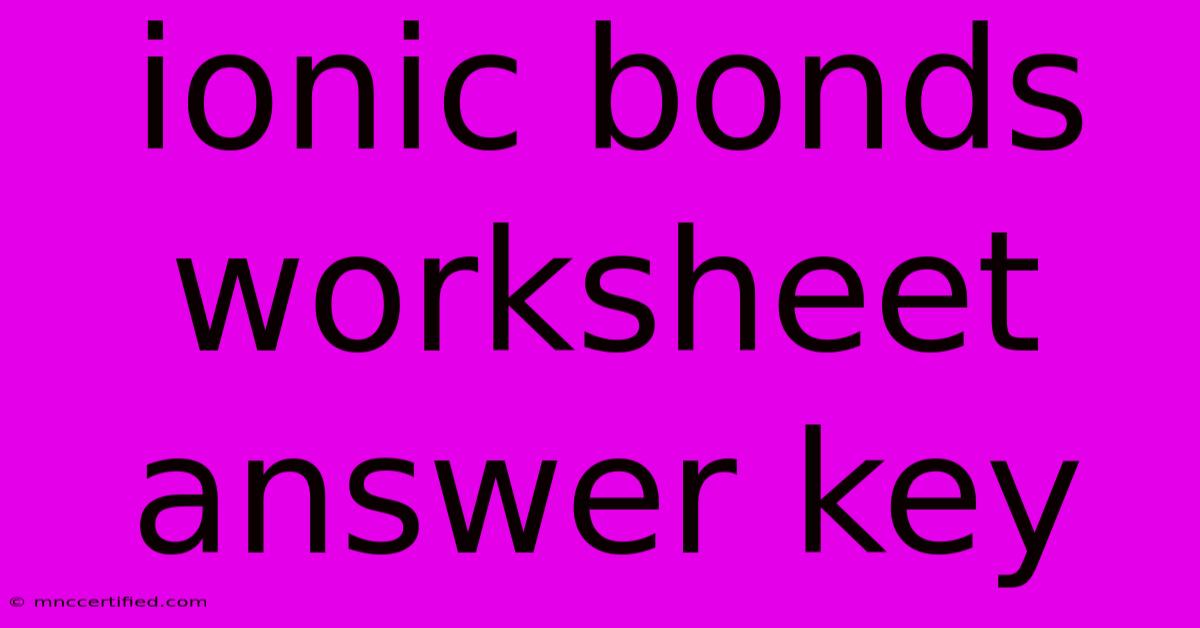Ionic Bonds Worksheet Answer Key

Table of Contents
Ionic Bonds Worksheet Answer Key: A Comprehensive Guide
Finding the right answer key for your ionic bonds worksheet can be tricky. This comprehensive guide provides not only answers but also a deeper understanding of ionic bonding, helping you ace your chemistry assignment and master this fundamental concept. We'll cover key concepts, provide example problems, and offer strategies for tackling similar worksheets in the future.
Understanding Ionic Bonds: The Basics
Before diving into the answers, let's refresh our understanding of ionic bonds. Ionic bonds form through the electrostatic attraction between oppositely charged ions. This happens when one atom (typically a metal) donates electrons to another atom (usually a nonmetal), forming a cation (positively charged ion) and an anion (negatively charged ion).
Key Characteristics of Ionic Compounds:
- High melting and boiling points: Due to the strong electrostatic forces between ions.
- Crystalline structure: Ions are arranged in a regular, repeating pattern.
- Conductivity: Conduct electricity when molten or dissolved in water because the ions become mobile.
- Brittle: The shift of layers of ions disrupts the electrostatic attractions, leading to breakage.
Example Ionic Bond Worksheet Problems and Solutions
Let's tackle some common problems found in ionic bonds worksheets. Remember, the key is to understand the electron transfer process and the resulting charges.
Problem 1: Predict the formula for the ionic compound formed between sodium (Na) and chlorine (Cl).
Solution: Sodium (Na) is in Group 1 and has one valence electron, readily losing it to achieve a stable octet. Chlorine (Cl) is in Group 17 and needs one electron to complete its octet. Therefore, one sodium atom donates one electron to one chlorine atom, forming Na⁺ and Cl⁻ ions. The resulting formula is NaCl (sodium chloride).
Problem 2: Determine the charges of the ions formed by magnesium (Mg) and oxygen (O). Then, write the formula for the ionic compound formed between them.
Solution: Magnesium (Mg) is in Group 2 and loses two electrons to form a Mg²⁺ ion. Oxygen (O) is in Group 16 and gains two electrons to form an O²⁻ ion. To balance the charges, one magnesium ion combines with one oxygen ion, resulting in the formula MgO (magnesium oxide).
Problem 3: Identify the type of bonding (ionic or covalent) in the following compounds: a) KCl b) H₂O c) CaO
Solution:
- a) KCl (Potassium Chloride): Ionic bond – potassium (metal) and chlorine (nonmetal).
- b) H₂O (Water): Covalent bond – both hydrogen and oxygen are nonmetals, sharing electrons.
- c) CaO (Calcium Oxide): Ionic bond – calcium (metal) and oxygen (nonmetal).
Advanced Ionic Bonding Concepts
Some worksheets might include more advanced concepts like:
- Polyatomic ions: Ions composed of more than one atom (e.g., sulfate (SO₄²⁻), nitrate (NO₃⁻)). Understanding their charges is crucial for predicting formulas.
- Transition metal ions: Transition metals can have multiple oxidation states, leading to different ion charges (e.g., Fe²⁺ and Fe³⁺).
- Lattice energy: The energy required to separate one mole of an ionic compound into its gaseous ions.
Tips for Success with Ionic Bonds Worksheets
- Memorize the periodic table: Understanding group numbers is essential for determining electron configurations and ion charges.
- Practice makes perfect: Work through many examples to solidify your understanding.
- Use resources wisely: Utilize online tutorials, textbooks, and your teacher's notes.
- Seek help when needed: Don't hesitate to ask your teacher or classmates for assistance.
Beyond the Answer Key: Mastering Ionic Bonding
This guide is more than just an answer key; it's a learning resource designed to improve your understanding of ionic bonding. While specific answers to your worksheet will depend on the problems presented, the principles and examples provided here should equip you to tackle any ionic bonding challenge. Remember that understanding the underlying concepts is key to success in chemistry. Good luck!

Thank you for visiting our website wich cover about Ionic Bonds Worksheet Answer Key. We hope the information provided has been useful to you. Feel free to contact us if you have any questions or need further assistance. See you next time and dont miss to bookmark.
Featured Posts
-
Russia Icbm Message To Ukraine West
Nov 21, 2024
-
34 65 An Hour Is How Much A Year
Nov 21, 2024
-
26 54 An Hour Is How Much A Year
Nov 21, 2024
-
Shaboozeys Cma Awards Whiskey Song
Nov 21, 2024
-
Iceland Volcano 10th Eruption Video
Nov 21, 2024